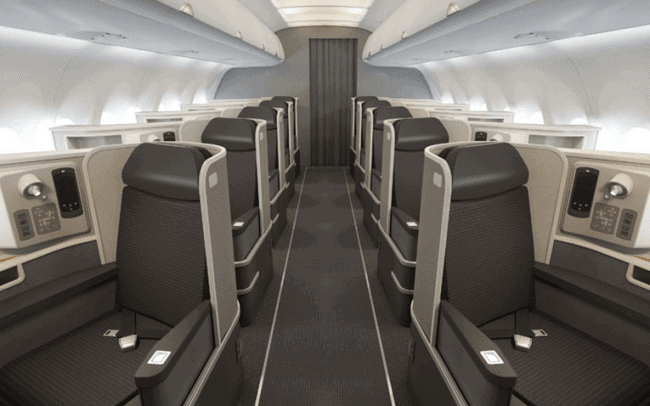MileValue is part of an affiliate sales network and receives compensation for sending traffic to partner sites, such as CreditCards.com. This compensation may impact how and where links appear on this site. This site does not include all financial companies or all available financial offers. Terms apply to American Express benefits and offers. Enrollment may be required for select American Express benefits and offers. Visit americanexpress.com to learn more.
Note: Some of the offers mentioned below may have changed or are no longer be available. You can view current offers here.
Prior to this weekend, American Airlines classified the premium cabin on all domestic flights (domestic First Class) as First Class, whether or not the plane had two cabins or three. It was distinguished with fare code F, A, or P. That changed over the weekend, and now the premium cabin on two cabin domestic flights is classifying as Business Class, distinguished with fare code J, D, or R, for flights beginning January 11, 2017 and onwards.
Wondering why this affects you?
The price of British Airways Avios awards are defined by two things:
- Distance of the segment
- Cabin segment is flown in
Old VS. New Avios Rates
Before this weekend, redeeming Avios on an American Airlines two-cabin domestic “First Class” award costed: 
Now, redeeming Avios on an American Airlines two-cabin domestic “First Class” award that flies January 11 or later costs:
Three cabin First Class will still be classified as First Class (F, A, or P), so those routes will continue to price as First Class awards (per the first chart).
For means of comparison, here is what it costs in American Airlines miles to fly American Airlines two-cabin domestic “First Class”:

So you can see that the sweetspot for redeeming Avios on American Airlines two-cabin domestic First Class is on flights between 500 miles and 2,000 miles, which will cost anywhere from 15k to 20k Avios compared to 25k American Airlines. Here are some examples of direct routes that fly a distance between 500 and 2,000 miles. They all cost 15k Avios vs. 25k American Airlines miles to fly domestic First Class:
- New York to Chicago (740 miles)
- New York to Miami (1,089 miles)
- Dallas to Los Angeles (1,235 miles)
- Phoenix to Atlanta (1,587 miles)
- Chicago to Los Angeles (1,744 miles)
Note though that that chart of AAdvantage prices does not account for possible discounts like Reduced Mileage Awards or the 10% rebate on redemptions for being a cardholder of the Citi / AAdvantage Platinum Select World Elite Mastercard.
Routes That Are Longer Than 2,000 Miles
The majority of direct American Airlines flights that fly a distance of 2,0001 to 3,000 miles fly three-cabin planes, so the Avios rate remains the same (50k) as the cabin is still classified as First Class (fare code F, A, or P). It also costs 50k American Airlines miles to fly three-cabin domestic First Class.

There are some two-cabin American Airlines planes that fly direct for more than 2,000 miles (like San Francisco to Philadelphia for example), and those awards now price at 37.5k Avios instead of 50k Avios. But the same award would only cost 25k American Airlines miles.
Honolulu to Los Angeles
American Airlines flies a two-cabin plane between Los Angeles and Honolulu. Just like the San Francisco to Philadelphia example I gave above, the route flies a distance between 2,000 and 3,000 miles, so the price in Avios has dropped from 50k to 37.5k since it’s now classified as Business Class (i.e. domestic “First Class”) instead of First. American Airlines actually charges 40k for the same award since Hawaii is in a different region. So now it’s cheaper to redeem Avios to Hawaii in American Airlines two-cabin First Class than it is American Airlines miles.
That being said, there isn’t nearly as much premium cabin award space flying American to Honolulu as there is United premium cabin award space, and you can book United Business Class award space with only 30k Singapore miles (and even fly an additional segment from your home airport to Los Angeles on United without changing the price).
Bottom Line
American Airlines changed the way they classify the front cabin in their two-cabin planes that fly within the United States. Instead of being labeled with fare code F, A, or P, which is considered First Class, they are now labeled J, D, or R, which is considered Business Class. The biggest difference this probably makes to you is that it cuts the price of Avios rates for the premium cabin in half for American Airlines flights that fly a distance of up to 2,000 miles. New fare buckets apply for flights January 11, 2017 and onwards.
Having trouble finding American Airlines award space on ba.com? FYI: American Airlines flights pre-January 11, 2017 might be showing errors on BA.com due to the change in fare buckets January 11. Per Rapid Travel Chai’s advice, you’ll need to call British Airways to book if you keep receiving error messages–make sure they waive the phone booking fee.
Hat tip The Points Guy


What about for avios redemption on Alaska first?
The pricing changes only apply to redemptions on American Airlines flights.
Is there a way to search for ‘direct’ flights (multi-segment with only one flight number) on American or Alaska Air in order to economize on the amount of Avios needed to reach a destination? It’s easy to search for nonstops, but hard to filter for ‘direct’.